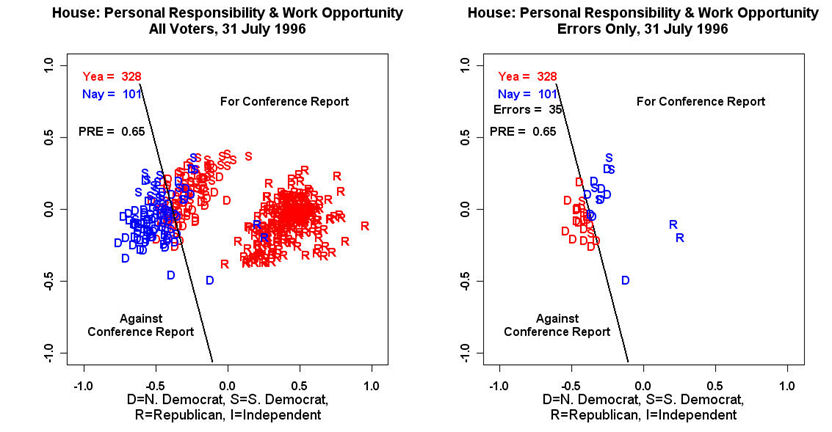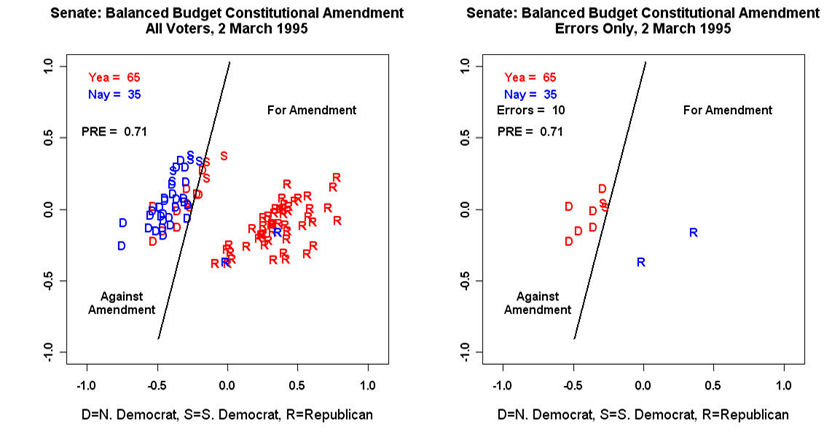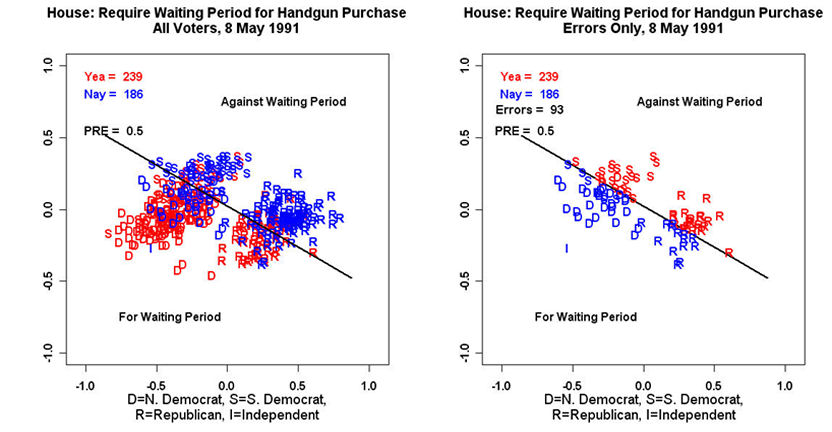Conservatism is a cultural, social, and political philosophy that seeks to promote and to preserve traditional institutions, practices, and values. The central tenets of conservatism may vary in relation to the culture and civilization in which it appears. In Western culture, conservatives seek to preserve a range of institutions such as organized religion, parliamentary government, and property rights. Conservatives tend to favor institutions and practices that guarantee stability and evolved gradually. Adherents of conservatism often oppose modernism and seek a return to traditional values, though different groups of conservatives may choose different traditional values to preserve.
A political spectrum is a system to characterize and classify different political positions in relation to one another. These positions sit upon one or more geometric axes that represent independent political dimensions. The expressions political compass and political map are used to refer to the political spectrum as well, especially to popular two-dimensional models of it.

The politics of the United States function within a framework of a constitutional federal republic and presidential system, with three distinct branches that share powers. These are: the U.S. Congress which forms the legislative branch, a bicameral legislative body comprising the House of Representatives and the Senate; the executive branch which is headed by the president of the United States, who serves as country's head of state and government; and the judicial branch, composed of the Supreme Court and lower federal courts, and which exercises judicial power.

The Republican Party, also referred to as the GOP, is one of the two major contemporary political parties in the United States. The GOP was founded in 1854 by anti-slavery activists who opposed the Kansas–Nebraska Act, which allowed for the potential expansion of chattel slavery into the western territories. Since Ronald Reagan's presidency in the 1980s, conservatism has been the dominant ideology of the GOP. It has been the main political rival of the Democratic Party since the mid-1850s. The Republican Party's historical predecessor is considered to be Northern members of the Whig Party, with Republican presidents Abraham Lincoln, Rutherford B. Hayes, Chester A. Arthur, and Benjamin Harrison all being Whigs before switching to the party, from which they were elected. The collapse of the Whigs, which had previously been one of the two major parties in the country, strengthened the party's electoral success.

The British Columbia Social Credit Party, whose members are known as Socreds, was the governing provincial political party of British Columbia, Canada, for all but three years between the 1952 provincial election and the 1991 election. For four decades, the party dominated the British Columbian political scene, with the only break occurring between the 1972 and 1975 elections when the British Columbia New Democratic Party governed.
The left–right political spectrum is a system of classifying political positions characteristic of left–right politics, ideologies and political parties with emphasis placed upon issues of social equality and social hierarchy. In addition to positions on the left and on the right, there are centrists or moderates who are not strongly aligned with either end of the spectrum.
A political realignment, often called a critical election, critical realignment, or realigning election, in the academic fields of political science and political history, is a set of sharp changes in party ideology, issues, party leaders, regional and demographic bases of power of political parties, and the structure or rules of the political system, such as voter eligibility or financing. The changes result in a new political power structure that lasts for decades, replacing an older dominant coalition. Scholars frequently invoke the concept in American elections and occasionally those of other countries. American examples include the 1896 United States presidential election, when the issues of the American Civil War political system were replaced with those of the Populist and Progressive Era, and the 1932 United States presidential election, when the Populist and Progressive Eras were replaced by the New Deal-era issues of New Deal liberalism and modern conservatism. Realigning elections typically separate party systems—with 1828, for example, separating the First Party System and the Second Party System in the US. It is generally accepted that the United States has had five distinct party systems, each featuring two major parties attracting a consistent political coalition and following a consistent party ideology, separated by four realignments.
Political polarization is the divergence of political attitudes away from the center, towards ideological extremes.
A party-line vote in a deliberative assembly is a vote in which a substantial majority of members of a political party vote the same way.
A big tent party, or catch-all party, is a term used in reference to a political party's policy of permitting or encouraging a broad spectrum of views among its members. This is in contrast to other kinds of parties, which defend a determined ideology, seek voters who adhere to that ideology, and attempt to convince people towards it.
The conservative coalition, founded in 1937, was an unofficial alliance of members of the United States Congress which brought together the conservative wings of the Republican and Democratic parties to oppose President Franklin Delano Roosevelt's New Deal. In addition to Roosevelt, the conservative coalition dominated Congress for four presidencies, blocking legislation proposed by Roosevelt and his successors. By 1937, the conservatives were the largest faction in the Republican Party which had opposed the New Deal in some form since 1933. Despite Roosevelt being a Democrat himself, his party did not universally support the New Deal agenda in Congress. Democrats who opposed Roosevelt's policies tended to hold conservative views, and allied with conservative Republicans. These Democrats were mostly located in the South. According to James T. Patterson: "By and large the congressional conservatives agreed in opposing the spread of federal power and bureaucracy, in denouncing deficit spending, in criticizing industrial labor unions, and in excoriating most welfare programs. They sought to 'conserve' an America which they believed to have existed before 1933."

The Republican Party, also referred to as the GOP, is one of the two major political parties in the United States. It is the second-oldest extant political party in the United States after its main political rival, the Democratic Party.

American political ideologies conventionally align with the left–right political spectrum, with most Americans identifying as conservative, liberal, or moderate. Contemporary American conservatism includes social conservatism, classical liberalism and economic liberalism. The former ideology developed as a response to communism and the civil rights movement, while the latter two ideologies developed as a response to the New Deal. Contemporary American liberalism includes progressivism, welfare capitalism and social liberalism, developing during the Progressive Era and the Great Depression. Besides modern conservatism and liberalism, the United States has a notable libertarian movement, and historical political movements in the United States have been shaped by ideologies as varied as republicanism, populism, separatism, socialism, monarchism, and nationalism.

The United States House of Representatives is the lower chamber of the United States Congress, with the Senate being the upper chamber. Together they comprise the national bicameral legislature of the United States.
Low information voters, also known as misinformation voters, are people who may vote yet are generally poorly informed about issues. The phrase is mainly used in the United States and has become popular since the mid-1990s.

The Supreme Court of the United States is the country's highest federal court. Established pursuant to Article Three of the U.S. Constitution in 1789, it has ultimate, and largely discretionary, appellate jurisdiction over all federal courts and state court cases involving issues of U.S. federal law, plus original jurisdiction over a small range of cases. In the legal system of the United States, the Supreme Court is generally the final interpreter of federal law including the U.S. Constitution, but it may act only within the context of a case in which it has jurisdiction. The Court may decide cases having political overtones, but does not have the power to decide political questions that are nonjusticiable, and its enforcement arm is in the executive rather than judicial branch of government.
Nolan Matthew McCarty is an American political scientist specializing in U.S. politics, democratic political institutions, and political methodology. He has made notable contributions to the study of partisan polarization, the politics of economic inequality, theories of policy-making, and the statistical analysis of legislative voting.

Howard Lewis Rosenthal was an American political scientist who was professor of politics at New York University. He also taught at Carnegie-Mellon University and Princeton University, where he was the Roger Williams Straus professor of social sciences.

Keith T. Poole is an American political scientist and the Philip H. Alston Jr. Distinguished Professor in the Department of Political Science at the University of Georgia. He has compiled and maintained datasets related to the United States Congress for forty years, and he has made them available on his website, Voteview, since 1995. Poole originally developed Voteview as a DOS program with Howard Rosenthal at Carnegie-Mellon University from 1989 to 1992. He also worked with Rosenthal on the development of the NOMINATE multidimensional scaling method to assess the voting behavior of members of Congress along a given dimension. He was inducted into the American Academy of Arts & Sciences in 2006. In 2016, he received the Society for Political Methodology's Career Achievement Award, and in 2018, the journal Public Choice published a special issue in his honor.

Political polarization is a prominent component of politics in the United States. Scholars distinguish between ideological polarization and affective polarization, both of which are apparent in the United States. In the last few decades, the U.S. has experienced a greater surge in ideological polarization and affective polarization than comparable democracies.













